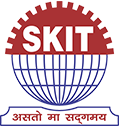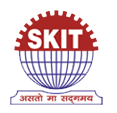Mathematics
Teaching Learning Process
INNOVATIONS IN TEACHING AND LEARNING
The First Pedestal
Innovation in education encourages teachers and students to explore newer avenues and use all tools to uncover something new. It involves a different perspective of addressing problems and solving them. Innovation does not mean creating something from nothing. It relies on developing the foundation for a keen insight to explore the world brimming up with myriad opportunities.
Setting the Foundation Right
Innovation in education is not just about using technology. It is also about searching the why, what and how of building a scientific and technological temperament. The teaching methods of the Department largely focus on developing this scientific temperament so that the students build on their potential and transform into constructive engineers. The students thus understand the importance of the application part and are encouraged to widen their scientific curiosity.
The Cornerstones of Innovative Methods
Many innovative initiatives taken by faculty and staff of the Department can be observed in the Course Files, Laboratory Manuals and Mini Projects given in the labs, Application based Activities and through other documents that are maintained in the Department. Moreover, the availability of ‘DSpace’ in the institute has rendered the three most important tasks related to establishing innovative practices namely recording, reviewing, and disseminating knowledge.
Statement of goals for innovations in teaching and learning
Apart from the regular teaching-learning experience imparted in classrooms, the Department is constantly thriving towards achieving the following:
• Enhance the understanding and knowledge of students with learning through discussion and interaction.
• Broaden the perspective of students where teachers trigger meaningful discussions in classrooms by encouraging students to ask open-ended questions, re-state remarks in more scientific language, and develop and use models to construct explanations.
• Motivate the students to think, formulate and actinnovatively through the process of identifying their true potential of applying their knowledge in the right context and relating it to what is already known.
• Help the students learn to think skillfully while dealing with the problems.
• Provide opportunity to learn and acquire the basic skills of applying their knowledge.
Innovative initiatives in teaching and learning process taken by the Department
The first step is the use of technology in the classroom by the faculty helps to engage the students with different kinds of stimuli and creates an environment of activity-based learning. It makes the content of the classroom more interesting and makes learning a fun.
Given below is a listing of some of the noticeable initiatives taken by the faculty of the Department. However, it should not be construed as a conclusive list; but as a part of an open-ended process of continuous improvement.
1. DSpace submissions: Faculty of the Department regularly uploads a lot of academic documents on the DSpace repository of SKIT. The portal is directly accessible from the institutional website: http://203.190.148.228:8080/xmlui/handle/123456789/29. The submissions include power point presentations, articles, lecture notes, lab manuals and many other useful documents that are beneficial for the students.
2. MOOCs (Massive Open Online Courses): MOOCs are a relatively new entry in the academic sector throughout the world. Although the role of MOOCs in effective dissemination of knowledge is still under debate, they are speedily gaining unquestioned
acceptance in more and more academic circles as an innovative means of imparting additional knowledge to students. Here at SKIT, we support augmenting our own efforts for the effective delivery by MOOCs available through agencies like NPTEL and SWAYAM.
3. Active learning: It is engaging students in doing something in addition to merely listening to a lecture and taking notes.Students may be involved in talking and listening to one another, or writing, reading and reflecting individually or in small groups. We tend to teach the way we were taught ourselves, rather than in the way that work best.
4. Power point presentations: Use of this widely accepted technique is done wherever deemed necessary in the Department. This has actually become a standard norm in the teaching-learning process, and is facilitated by the fact that all our classrooms are well-
equipped with high quality projectors ready for use any time.
5. Additional efforts for weak students: Students unable to score well in the term exams are identified and are given more attention by faculty. In many cases, they are tasked with additional assignments to enhance their understanding of the respective subjects.
6. E-mail correspondence with students: Faculty frequently engages in e-mail correspondence with the students to share notes, remarks, assignments and test results. This significantly boosts the out-of-class learning experience of students.
7. Audio-visual learning: Audio-visual aids are used wherever necessary. It is a proven fact that audio-visual presentations in the classrooms are more effective in capturing the attention of students.
8. Classroom quiz sessions: It promotes an interactive way of learning and also helps towards invoking interest in the subject.
9. Adherence to Bloom’s taxonomy: The Question papers of mid-term tests for all subjects are made in strict adherence to the Bloom’s taxonomy. This ensures that the learning as well as the assessment mechanism is based on standard practices of the academic fraternity worldwide.
10. Personal counseling: This has helped many students in dealing with academic as well as personal problems. Every faculty in the Department acts as a counselor to any student with any problem he/she is willing to share.
11. Compulsory attendance: The classroom is a microcosm of the world. The students must understand to participate in constructing knowledge. For this process to be effective it must have relevance to have compulsion of 75% attendance in the class.
12. Development of e content: Besides classroom teaching, e content and video lectures prepared by the faculty members are also provided to the students .





